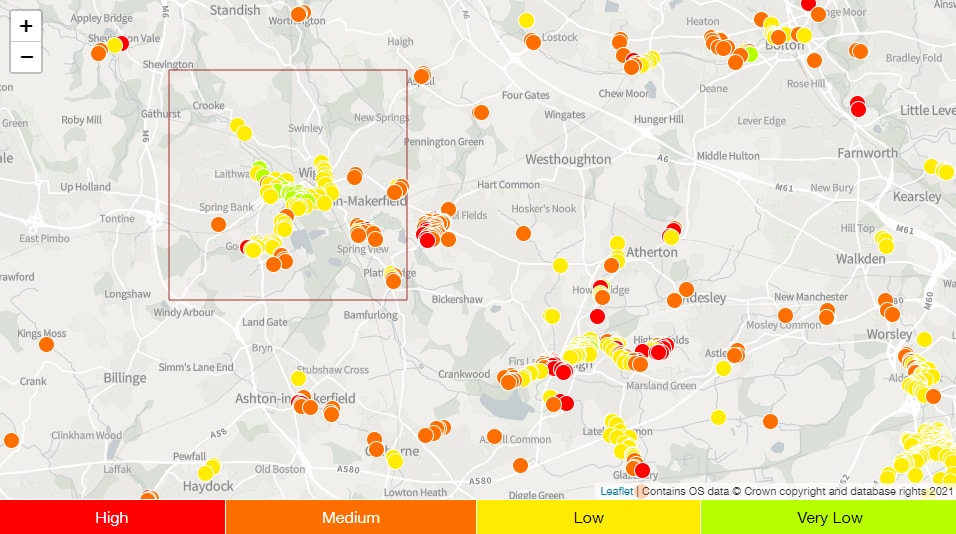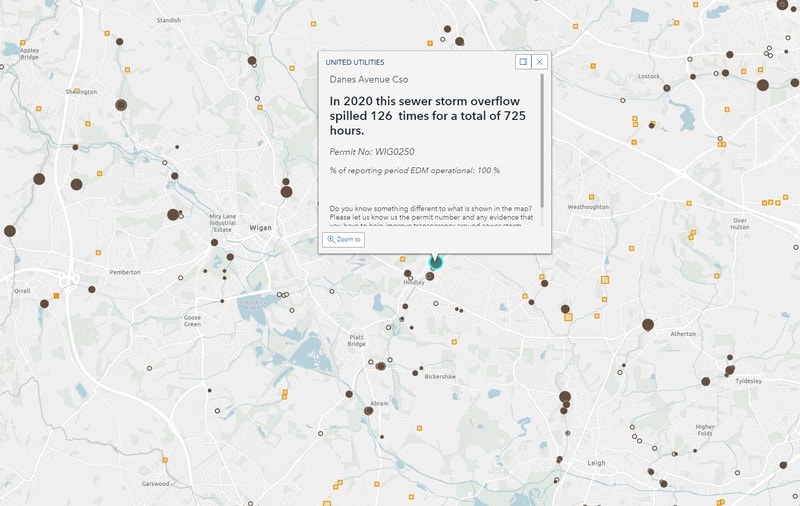Most Wiganers will have seen a flood or 2… at least! I know where I am by Saddle Junction in Wigan Town centre, it floods quite severely at least once or twice a year, cutting off roads and damaging houses.
Here, it costs thousands of pounds of damage, and it causes delays and tremendous stress. And In the UK overall the cost of flood damage is estimated to be £1 Billion per year!
This flood map shows just how prone we are here to flooding in Wigan Borough. Red is High and Orange is Medium

Part of this, is that the drains overflow every time they’re overwhelmed with stormwater. Here’s an interactive map where you can see how often storm drain overflow in Wigan. That’s a lot of dirty water!

So how can we help to tackle flooding at home?
Remove hard surfaces
The increase in paving is a UK wide trend, usually due to parking, reduction in maintenance and patio space, but we should consider before we add to the problem.
When we pave with a hard surface like tarmac or concrete or, to a slightly lesser extent paving slabs, surface water from rain doesn’t soak in, and it just runs right off and into the drains. This causes them to overflow, as we’ve seen in person, and on the maps above.
Water runoff from paving is 55%, with only 15% infiltration into the ground. (When paving covers 75% of an area)
Water runoff from plants and grass is just 20%, with 42% infiltration into the ground. And 8% more rain is evaporated back into the air. (When they cover 80%- 90% of an area)
Quite a big difference!
Even a lawn with nothing much else will soak in water during a shower. But not an artificial one, this may be obvious, but they’re plastic and often have concrete underneath!
If you have a front yard with no intention of parking your car (I see this locally in a lot of the old Victorian Terraces) could you plant a hedge or some shrubs instead, or even a flower bed if it’s sunny? You needn’t remove all; lifting a few flags to make a border will make a difference.
Removing concrete is more challenging. When I moved into my house, the entire garden area was concrete. With multiple heavy breakers, long days, skips and diggers, we removed it all. It was one hell of a job! I believe ours was reinforced, and so it was thicker than you often find, but please be careful if attempting to remove concrete.
By the way, it was well worth it! I’ve turned my garden slowly into a luscious green space with a small paved path and patio area, but mostly large bushes, flowers, small trees and a bit of lawn space to play.
Garden maintenance isn’t as hard as it seems. There’s plenty of advice and ideas on our blog to help give you a hand and get started.
Gardening is also very therapeutic; it’s shown to have multiple benefits to mental and psychical health and is even shown to slow ageing!
If you want a hard surface area, look to gravel, loose stones or even woodchips (great for play areas). They’re more permeable than concrete or paving and so will absorb more surface water in heavy rainfall. But they’re still pretty low maintenance.
To make a feature of your paving, you can also space paving stones a little and plant between them (for example, low lying thyme) to make stepping stones. Or have a mix of paving and gravel together.
Even a number of pots on a patio will make a small difference, but the bigger, the better where possible.
There are many creative ways to create a space that works for you and helps you reduce flooding in your area. If we all make small steps and consider what we do in our gardens, the potential is huge.
Plant Trees
Trees can benefit in a number of ways when it comes to flood prevention. The leaves catch rainwater and so preventing some of it from getting to the ground in the first place, this is then evaporated back into the air.
Water then runs down the trunk directly towards the roots, which draw up and store the water. The roots also increase the soil’s ability to absorb moisture and help prevent soil erosion. The water is then filtered by the root system before entering the water table.
All technical stuff, but basically they do a great job of naturally reducing the rainfall to the ground and slowing it down, filtering it once it does land.
Use a water butt
Installing a water butt will not only reduce flooding, but it’s a clever use of water. They’re often very cheap or free and easy to install.
And it saves water going down the drain needlessly when your plants would love some in drier times. I find mine immensely useful.
If your garden floods
If your garden is already prone to waterlog and flooding, you’ll already know the struggle to get plants to grow well. It causes the roots to rot and can compact the soil—a potential nightmare.
Paving isn’t the answer! It only increases the problem for those around you. There are ways to reduce it and embrace it.
Hot tip, if the ground is very waterlogged, don’t tread on it! It’ll compact the soil and make it harder to work with – making the problem worse, always garden when it’s drier.
Here are a few ideas to work with a waterlogged garden
Green Roof Can you install a green roof? Over a bin store perhaps or the shed. This will soak in excess rainwater and look beautiful.
Drainage ditch Channel the water, so it drains away better if possible. Either by making a little ditch or using a drainage system.
Waterbutt Install a waterbutt or 2 to catch rainwater and use it on the garden.
Raised beds Creating and planting on raised beds will absorb more water, and they tend to drain better
Large plants Include large leafy plants and trees in your plans, and some evergreens will also hold more water. They also shelter the soil.
Improve the soil If your soil is very clay-like, it’s more prone to waterlogging. Reducing clay in the soil can be a tough job, rotavators can really help if you can buy or borrow one. Then dig in a good organic mix like manure of composted bark to try and balance the clay content. (Wait until it’s dry to do this work)
In a boggier area, choose plants and trees that don’t mind the wetter soil, such a Hosta and Astilbe. Here is a complete list of water-loving plants
Make a rain garden If you notice water build up naturally in a spot, you could consider a water garden. You can channel the water more directly and make a beautiful lush area. A few plants well suited to this are Iris, Clustered Bellflower, and Mombresias.
The RHS have a great guide on rain gardens here too
Hopefully, these tips and ideas will help you collect more water in your garden for use, and save it from going into our overwhelmed drains and rivers.
3 Comments
-
[…] how much paving you actually need too, it’s expensive and contributes to flooding, so maybe a border instead of some flags would […]
-
[…] written about flooding in Wigan before; here are some tips to reduce flooding in your […]

[…] also wrote about flooding in Wigan and how to reduce flooding in your garden […]